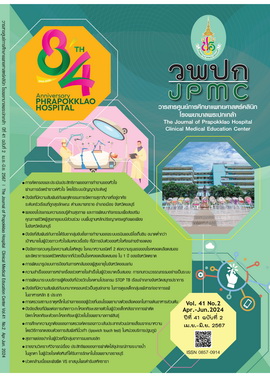ความสำเร็จของการหย่าเครื่องช่วยหายใจในผู้ป่วยบาดเจ็บสมอง: การทบทวนวรรณกรรมอย่างเป็นระบบ
Main Article Content
บทคัดย่อ
ที่มาของปัญหา: การใช้เครื่องช่วยหายใจในผู้ป่วยบาดเจ็บสมองช่วยรักษาภาวะคุกคามต่อชีวิต หากใช้เครื่องช่วยหายใจเป็นเวลานานส่งผลให้เกิดผลลัพธ์ที่ไม่ดีตามมา เช่น ปอดอักเสบติดเชื้อ
วัตถุประสงค์: สรุปองค์ความรู้เกี่ยวกับความสำเร็จของการหย่าเครื่องช่วยหายใจสำเร็จในผู้ป่วยบาดเจ็บสมอง
วิธีการศึกษา: การทบทวนวรรณกรรมอย่างเป็นระบบมีกลุ่มตัวอย่างคือ งานวิจัยที่เกี่ยวกับการหย่าเครื่องช่วยหายใจสำเร็จในผู้ป่วยบาดเจ็บสมอง โดยสืบค้นคำสำคัญตามหลักพิโกตั้งแต่ปี พ.ศ. 2561-2566 เครื่องมือวิจัยได้แก่ แบบสกัดข้อมูลงานวิจัยตามเกณฑ์การคัดเลือกงานวิจัย และแบบประเมินคุณภาพงานวิจัยรูปแบบงานวิจัยพรรณนาพัฒนาโดยสถาบันโจแอนนาบริกส์ ผลการสืบค้นได้งานวิจัยตามเกณฑ์คัดเข้าจำนวน 7 เรื่อง ซึ่งไม่สามารถเปรียบเทียบข้อมูลผลลัพธ์ได้ จึงใช้การสรุปเชิงเนื้อหาเพื่อสรุปองค์ความรู้ที่ได้จากการทบทวนวรรณกรรมอย่างเป็นระบบ
ผลการศึกษา: ความสำเร็จของการหย่าเครื่องช่วยหายใจสำเร็จในผู้ป่วยบาดเจ็บสมอง ได้แก่ ระดับความรู้ตัวทางระบบประสาทร่วมกับความสามารถในการไอขับเสมหะ การกลืน และปริมาณเสมหะน้อย ร่วมกับการประเมินความพร้อมของการหย่าเครื่องช่วยหายใจทุกวัน การฝึกการหายใจเอง การประเมินการถอดท่อช่วยหายใจ และการติดตามบันทึกการหย่าเครื่องช่วยหายใจ
สรุป: ข้อสรุปที่สอดคล้องกับงานวิจัยที่วิเคราะห์ความสำเร็จของการหย่าเครื่องช่วยหายใจในผู้ป่วยบาดเจ็บสมองช่วยลดระยะเวลาการใช้เครื่องช่วยหายใจ ลดระยะเวลาการอยู่ในหอผู้ป่วยวิกฤต และลดการเกิดภาวะแทรกซ้อนทางปอด
Article Details

อนุญาตภายใต้เงื่อนไข Creative Commons Attribution-NonCommercial-NoDerivatives 4.0 International License.
เอกสารอ้างอิง
Cinotti R, Bouras M, Roquilly A, Asehnoune K. Management and weaning from mechanical ventilation in neurologic patients. Ann Transl Med [Internet]. 2018 [cited 2023 Dec 12];6(19):381. Available from: https://atm.amegroups.org/article/view/20801/pdf
Shi ZH, Jonkman AH, Tuinman PR, Chen GQ, Xu M, Yang YL, et al. Role of a successful spontaneous breathing trial in ventilator liberation in brain-injured patients. Ann Transl Med [internet]. 2021 [cited 2023 Dec 13];9(7):548.Available from: https://atm.amegroups.org/article/view/66754/pdf
Bureau C, Demoule A. Weaning from mechanical ventilation in neurocritical care. Rev Neurol (Paris) 2022;178:111-20.
da Silva AR, Novais MCM, Neto MG, Correia HF. Predictors of extubation failure in neurocritical patients: A systematic review. Aust Crit Care 2023;36:285-91.
Battaglini D, SiwickaGieroba D, Brunetti I, Patroniti N, Bonatti G, Rocco PRM, et al. Mechanical ventilation in neurocritical care setting: a clinical approach. Best Pract Res Clin Anaesthesiol 2021;35:207-20.
Robba C, Poole D, McNett M, Asehnoune K, Bösel J, Bruder N, et al. Mechanical ventilation in patients with acute brain injury: recommendations of the European Society of Intensive Care Medicine consensus. Intensive Care Med 2020;46:2397-2410.
Robba C, Citerio G, Taccone FS, Galimberti S, Rebora P, Vargiolu A, et al. Multicentre observational study on practice of ventilation in brain injured patients: the VENTIBRAIN study protocol. BMJ Open [Internet]. 2021 [cited 2024 Jan 2];11(8):e047100. Available from: https://www.ncbi.nlm.nih.gov/pmc/articles/PMC8359464/pdf/bmjopen-2020-047100.pdf
Chaiyafong S, Kenthongdee W, Tongtem E. The development of clinical nursing practice guideline for weaning from mechanical ventilation in patients with brain surgery, surgical intensive care unit, Loei hospital. Journal of Nursing Division 2022;49(1):49-63.
Khalil NS, Mohamed WY, Sharkawy MAM. Patients’ weaning from mechanical ventilation: complete versus incomplete ventilator bundle implementation. IJANS 2018;8:28-32.
Belenguer-Muncharaz A, Díaz-Tormo C, Granero-Gasamans E, Mateu-Campos ML. Protocol-directed weaning versus conventional weaning from mechanical ventilation for neurocritical patients in an intensive care unit: a nonrandomized quasi experimental study. Crit Care Sci 2023;35:44-56.
Bösel J, Rabinstein AA. Extubation failure in patients with acute brain injury: a major problem still awaiting a solution. Intensive Care Med 2022;48:1611-3.
Aromataris E, Lockwood C, Porritt K, Pilla B, Jordan Z, editors. JBI Manual for Evidence Synthesis [Internet]. 2020 [cited 2023 Dec 26]. Available from: https://jbi-global-wiki.refined.site/space/MANUAL
Kummatid A, Markrat M. Using the systematic review to provide a complete summary on a research question in evidence based practice: a 3-step method. The Southern College Network Journal of Nursing and Public Health 2016;3(3):246-59.
Wahlster S, Sharma M, Taran S, Town JA, Stevens RD, Cinotti R, et al. Utilization of mechanical power and associations with clinical outcomes in brain injured patients: a secondary analysis of the extubation strategies in neuro-intensive care unit patients and associations with outcome (ENIO) trial. Crit Care [Internet]. 2023[cited 2024 Jan 1];27(1):156.Available from: https://www.ncbi.nlm.nih.gov/pmc/articles/PMC10120226/pdf/13054_2023_Article_4410.pdf
Huang HY, Lee CS, Chiu TH, Chen HH, Chan LY, Chang CJ, et al. Clinical outcomes and prognostic factors for prolonged mechanical ventilation in patients with acute stroke and brain trauma. J Formos Med Assoc 2022;121(1 Pt 1):162-9.
Page M J, McKenzie JE, Bossuyt PM, Boutron I, Hoffmann TC, Mulrow CD, et al. The PRISMA 2020 statement: an updated guideline for reporting systematic reviews. BMJ [Internet]. 2021 [cited 2024 Jan 1];10:1-11. Available from: https://www.bmj.com/content/bmj/372/bmj.n71.full.pdf

